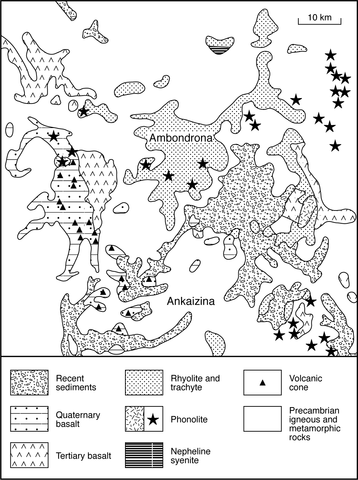stripes
Under the general name Ankaizina are included several extensive and a number of smaller volcanic fields lying to the east and southeast of the Ampasindava province. No modern, full account of the area has been found the most useful reference proving to be that of Besairie (1972). The general distribution of the rocks is, however, clearly shown on the 1:500,000 geological map (Besairie, 1971b). The occurrence comprises several large basaltic lava fields in the west, including Maroangoaka and Bemanevika, extending over some 100s of km2. Ambondrona is an irregularly-shaped volcanic field of trachytes and rhyolites some 50 km from southwest to northeast in which the volcanic rocks attain a thickness of 1000 m. A similar, but smaller, field lies to the east of Ambondro. Within the trachyte-rhyolite fields are numerous phonolite plugs and a swarm of these also occurs to the northeast cutting Precambrian gneisses and schists. A general volcanic succesion given by Jourde (1963) and Besaire (1972) is, from the bottom upwards, (1) rhyolites, trachytes and ignimbrites; (2) basalts and basanitoids; (3) trachyphonolites and phonolites; (4) plateau basalts and basanitoids and (5) recent basalts and basanitoids. In the northern part of the area, at Antsahalalina, there is a zone containing numerous dykes and intrusive breccias of syenite and nepheline microsyenite, while south of Manirenja, which is located on the large western basaltic field, an annular structure of phonolite and microsyenite has been described (Besairie, 1972). The rock types found in the numerous intrusions throughout the area include berondrite, bekinkinite, luscladite, which are all varieties of theralite, as well as phonolite, nepheline syenite and aegirine-bearing syenite. Also widespread through the area are intrusions of trachyte and rhyolite, as well as ignimbrites, that are often expressed morphologically as spines and steep conical hills. Aegirine occurs in the rhyolites, but information on what proportion of the rocks are peralkaline has not been found. Trachyphonolite and phonolite form flows and these rock types together with foid syenite also produce plugs, many of which have weathered to spines and other projections. Nosean-bearing syenite, hauyne-nepheline phonolite and tahitite are represented amongst this group of rocks. The basaltic rocks occur predominantly as flows and some tuffs and other pyroclastic rocks occur. Little is known of the centres from which the plateau basalts were erupted but the more recent series are distinguished by better preserved volcanic forms including calderas, some of which are occupied by lakes. Five of nine whole rock analyses quoted in Besairie (1972), and named basanitoid or basalt, fall in the tephrite-basanite field of the TAS system (Le Maitre et al., 1989) and one in the foidite field, suggesting that these rocks are indeed basanites (some certainly contain olivine). The last one, however, could conceivably be a nephelinite.
BESAIRIE, H. 1971b. Carte Géologique. Feuille 2. Antalaha. 1:500,000. Service Géologique de Madagasikara, Tananarive.BESAIRIE, H. 1972. Mise au point sur le volcanisme de l’Ankaizina (Madagascar). Comptes Rendus de la Semaine Géologique 1971. Comité National Malgache de Géologie. Imprimerie Nationale Tananarive, 35-8.JOURDE, G. 1963. Le Haut-Sambirano et les massifs du Tsaratanàna et de l’Amborona à Madagascar. Annales Géologiques de Madagascar. Comptes Rendus de la Semaine Géologique 1963, 33: 89-95.LE MAITRE, R.W., BATEMAN, P., DUDEK, A., KELLER, J., LAMEYRE, J., LE BAS, M.J., SABINE, P.A., SCHMID, R., SORENSEN, H., STRECKEISEN, A., WOOLLEY, A.R. and ZANETTIN, B. 1989. A classification of igneous rocks and glossary of terms: recommendations of the International Union of Geological Sciences Subcommission on the Systematics of Igneous Rocks. Blackwell, Oxford. 193 pp.

